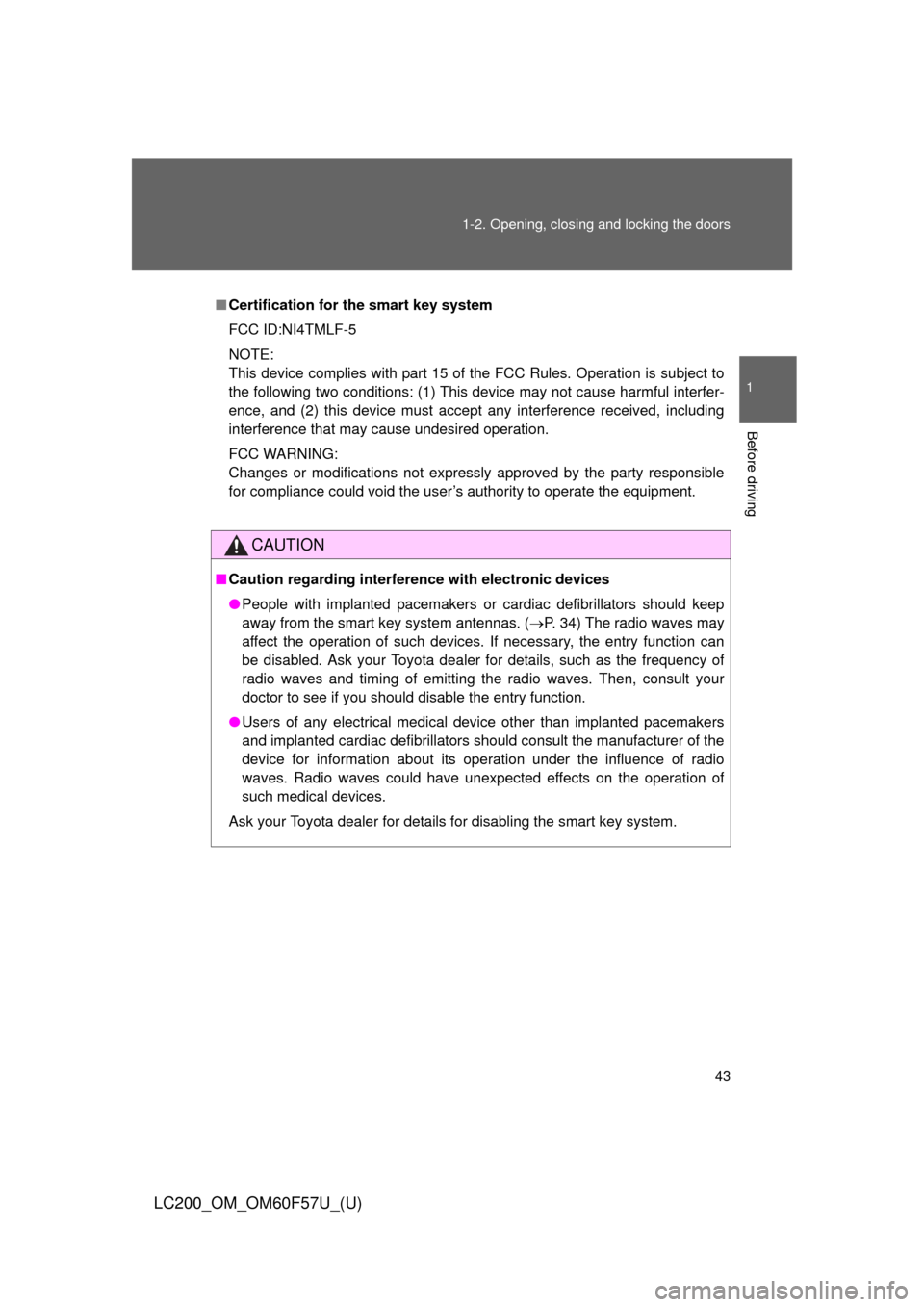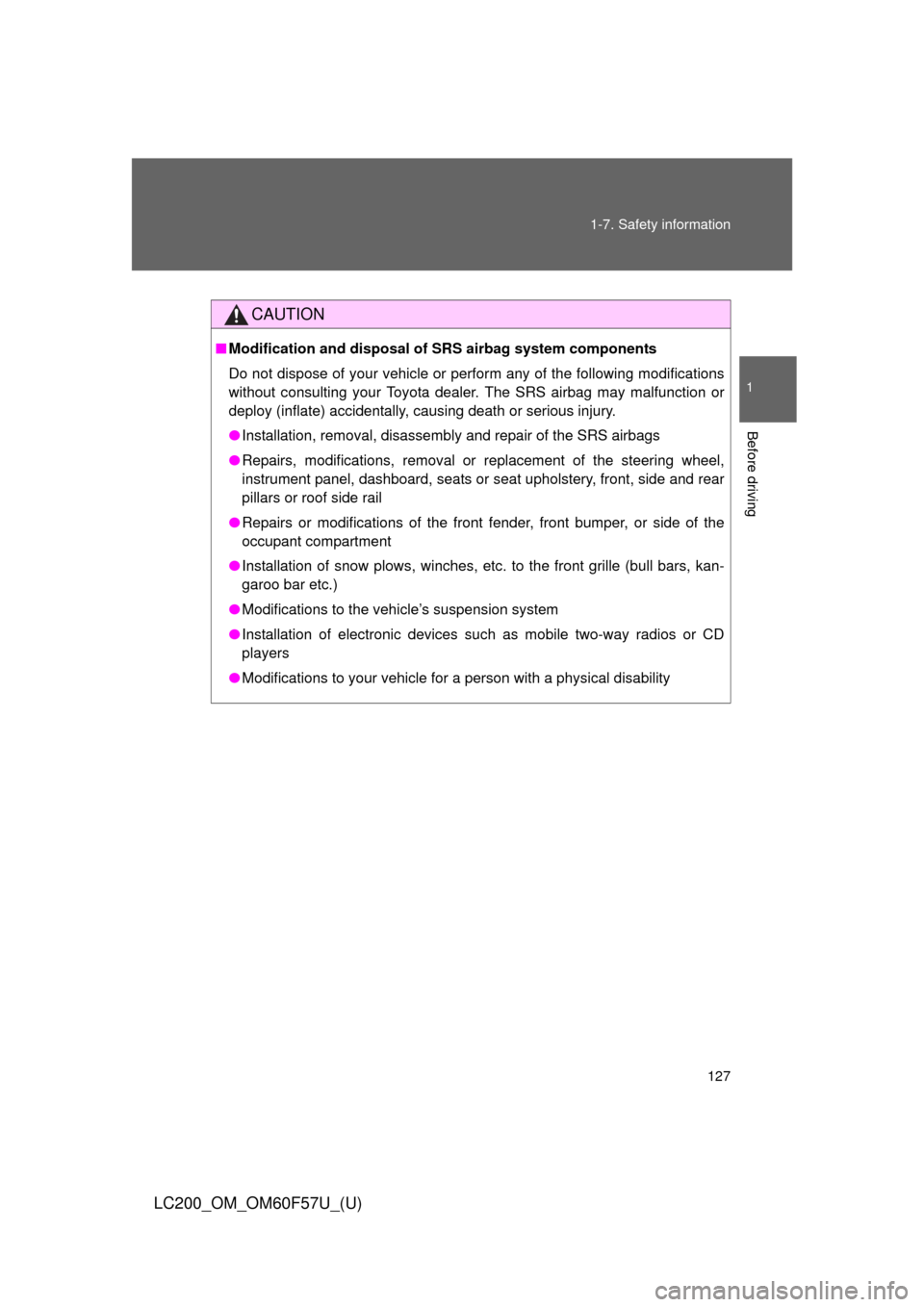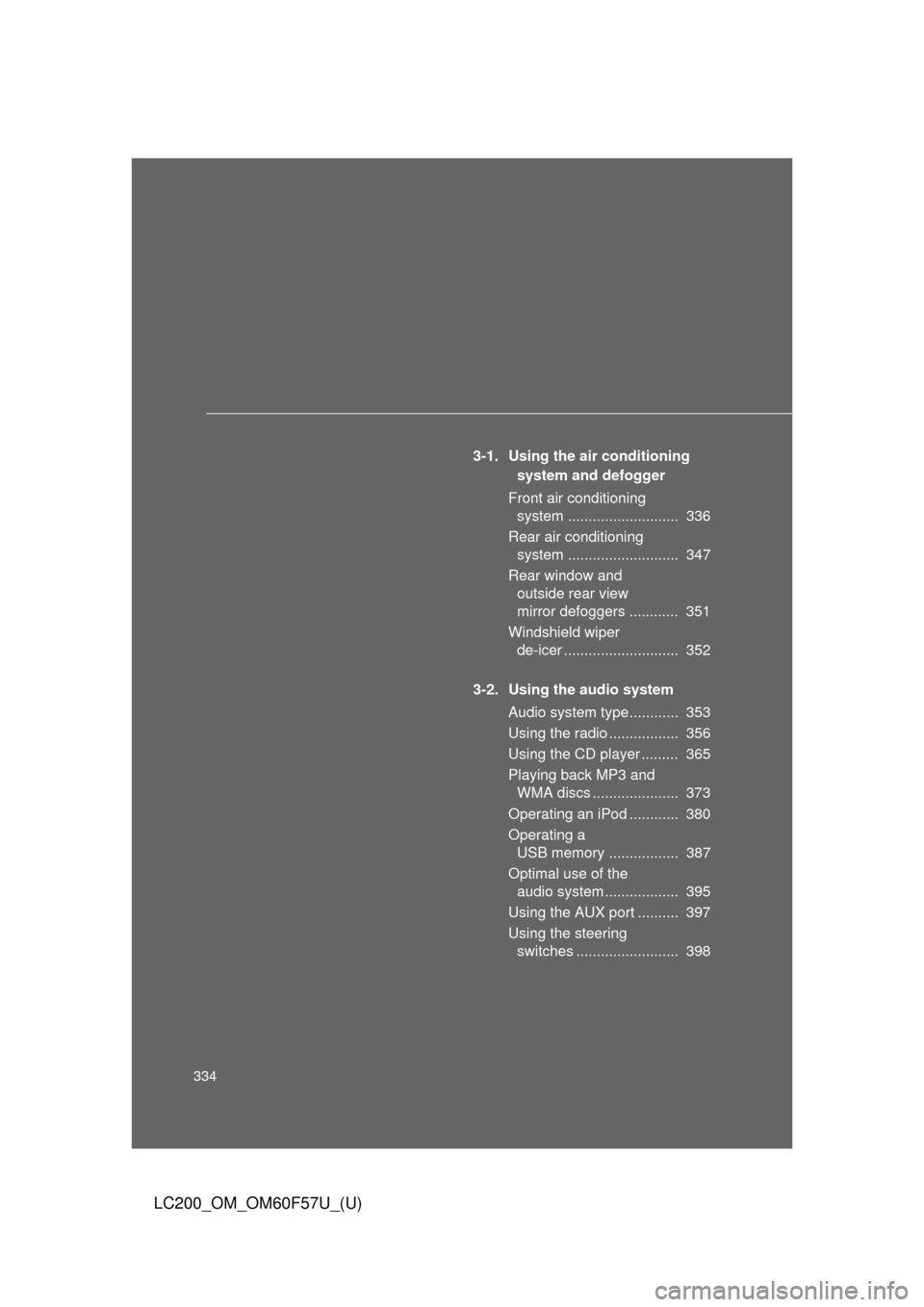radio TOYOTA LAND CRUISER 2013 J200 Owners Manual
[x] Cancel search | Manufacturer: TOYOTA, Model Year: 2013, Model line: LAND CRUISER, Model: TOYOTA LAND CRUISER 2013 J200Pages: 720, PDF Size: 21.46 MB
Page 4 of 720

TABLE OF CONTENTSIndex
4
LC200_OM_OM60F57U_(U)
3-1. Using the air conditioning
system and defogger
Front air conditioning
system .............................. 336
Rear air conditioning
system .............................. 347
Rear window
and outside rear view
mirror defoggers............... 351
Windshield wiper de-icer .... 352
3-2. Using the audio system
Audio system type .............. 353
Using the radio ................... 356
Using the CD player ........... 365
Playing back MP3 and
WMA discs ....................... 373
Operating an iPod .............. 380
Operating a
USB memory.................... 387
Optimal use of the
audio system .................... 395
Using the AUX port ............ 397
Using the steering
switches ........................... 3983-3. Using the Bluetooth
®
audio system
Bluetooth
® audio system .... 402
Using the Bluetooth®
audio system .................... 406
Operating a Bluetooth
®
enabled portable player .... 412
Setting up a Bluetooth
®
enabled portable player .... 415
Bluetooth
® audio system
setup ................................. 422
3-4. Using the hands-free system
(for cellular phone)
Hands-free system
(for cellular phone) ........... 423
Using the hands-free
system .............................. 428
Making a phone call............ 436
Setting a cellular phone ...... 441
Security and system
setup ................................. 447
Using the phone book......... 453
3-5. Using the interior lights
Interior lights list.................. 462
• Interior lights ..................... 463
• Personal lights .................. 464
3-6. Using the storage features
List of storage features ....... 466
• Glove box ......................... 467
• Console box ..................... 468
• Overhead console ............ 469
• Cup holders ...................... 470
• Bottle holders ................... 472
• Card holders ..................... 474
• Auxiliary boxes ................. 474
3Interior features
Page 23 of 720

23
LC200_OM_OM60F57U_(U)
Installation of a mobile two-way radio system
The installation of a mobile two-way radio system in your vehicle could affect
electronic systems such as:
●Multiport fuel injection system/sequential multiport fuel injection system
●Cruise control system
●Dynamic radar cruise control system
●Anti-lock brake system
●SRS airbag system
●Seat belt pretensioner system
Be sure to check with your Toyota dealer for precautionary measures or spe-
cial instructions regarding installation of a mobile two-way radio system.
Page 31 of 720

31 1-1. Key information
1
Before driving
LC200_OM_OM60F57U_(U)
■When required to leave the vehicle’s key with a parking attendant
Lock the glove box as circumstances demand. (P. 467)
Remove the mechanical key for your own use and provide the attendant with
the electronic key only.
■Key number plate
Keep the plate in a safe place such as your wallet, not in the vehicle. In the
event that a key is lost, a new key can be made at your Toyota dealer using
the key number plate. (P. 650)
■When riding in an aircraft
When bringing an electronic key onto an aircraft, make sure you do not
press any buttons on the electronic key while inside the aircraft cabin. If you
are carrying an electronic key in your bag etc., ensure that the buttons are
not likely to be pressed accidentally. Pressing a button may cause the elec-
tronic key to emit radio waves that could interfere with the operation of the
aircraft.
NOTICE
■To prevent key damage
●Do not subject the keys to strong shocks, expose them to high tempera-
tures by placing them in direct sunlight, or get them wet.
●Do not expose the keys to electromagnetic materials or attach any mate-
rial that blocks electromagnetic waves to the key surface.
●Do not disassemble the electronic key.
Page 36 of 720

36 1-2. Opening, closing and locking the doors
LC200_OM_OM60F57U_(U)
■Operation signals
A buzzer sounds and the emergency flashers flash to indicate that the doors
have been locked/unlocked. (Locked: Once; Unlocked: Twice)
■Conditions affecting operation
The smart key system uses weak radio waves. In the following situations,
the communication between the electronic key and the vehicle may be
affected, preventing the smart key system and wireless remote control from
operating properly. (Ways of coping P. 651)
●When the electronic key battery is depleted
●Near a TV tower, electric power plant, gas station, radio station, large dis-
play, airport or other facility that generates strong radio waves or electri-
cal noise
●When carrying a portable radio, cellular phone, cordless phone or other
wireless communication devices
●When the electronic key has come into contact with, or is covered by a
metallic object
●When multiple electronic keys are in the vicinity
●When carrying or using the electronic key together with the following
devices that emit radio waves
• Another vehicle’s electronic key
• A wireless key that emits radio waves
• Personal computer
●If window tint with a metallic content or metallic objects are attached to
the rear window
Page 39 of 720

39 1-2. Opening, closing and locking the doors
1
Before driving
LC200_OM_OM60F57U_(U)
■Note for the smart key system
●Even when the electronic key is within the effective range (detection
areas), the system may not operate properly in the following cases:
• The electronic key is too close to the window or outside door handle,
near the ground, or in a high place when the doors are locked or
unlocked.
• The electronic key is near the ground or in a high place, or too close to
the rear bumper center when the back door is locked or unlocked.
• The electronic key is on the instrument panel, floor or in the glove box
when the engine is started or “ENGINE START STOP” switch modes
are changed.
●Do not leave the electronic key on top of the instrument panel or near the
door pockets when exiting the vehicle. Depending on the radio wave
reception conditions, it may be detected by the antenna outside the cabin
and the door will become lockable from the outside, possibly trapping the
electronic key inside the vehicle.
●As long as the electronic key is within the effective range, the doors may
be locked or unlocked by anyone.
●Even if the electronic key is not inside the vehicle, it may be possible to
start the engine if the electronic key is near the window.
●The doors may unlock if a large amount of water splashes on the door
handle, such as in the rain or in a car wash. (The doors will automatically
be locked after approximately 60 seconds if the doors are not opened
and closed.)
●Gripping the door handle when wearing a glove may not unlock the door.
●If the wireless remote control is used to lock the doors when the elec-
tronic key is near the vehicle, there is a possibility that the door may not
be unlocked by the smart key system. (Use the wireless remote control to
unlock the doors.)
●A sudden approach to the effective range or door handle operation may
prevent the doors from being unlocked. In this case, return the door han-
dle to the original position and check that the doors unlock before pulling
the door handle.
■When the vehicle is not driven for extended periods
To prevent theft of the vehicle, do not leave the electronic key within 6 ft. (2
m) of the vehicle.
Page 43 of 720

43 1-2. Opening, closing and locking the doors
1
Before driving
LC200_OM_OM60F57U_(U)
■Certification for the smart key system
FCC ID:NI4TMLF-5
NOTE:
This device complies with part 15 of the FCC Rules. Operation is subject to
the following two conditions: (1) This device may not cause harmful interfer-
ence, and (2) this device must accept any interference received, including
interference that may cause undesired operation.
FCC WARNING:
Changes or modifications not expressly approved by the party responsible
for compliance could void the user’s authority to operate the equipment.
CAUTION
■Caution regarding interference with electronic devices
●People with implanted pacemakers or cardiac defibrillators should keep
away from the smart key system antennas. (P. 34) The radio waves may
affect the operation of such devices. If necessary, the entry function can
be disabled. Ask your Toyota dealer for details, such as the frequency of
radio waves and timing of emitting the radio waves. Then, consult your
doctor to see if you should disable the entry function.
●Users of any electrical medical device other than implanted pacemakers
and implanted cardiac defibrillators should consult the manufacturer of the
device for information about its operation under the influence of radio
waves. Radio waves could have unexpected effects on the operation of
such medical devices.
Ask your Toyota dealer for details for disabling the smart key system.
Page 127 of 720

127 1-7. Safety information
1
Before driving
LC200_OM_OM60F57U_(U)
CAUTION
■Modification and disposal of SRS airbag system components
Do not dispose of your vehicle or perform any of the following modifications
without consulting your Toyota dealer. The SRS airbag may malfunction or
deploy (inflate) accidentally, causing death or serious injury.
●Installation, removal, disassembly and repair of the SRS airbags
●Repairs, modifications, removal or replacement of the steering wheel,
instrument panel, dashboard, seats or seat upholstery, front, side and rear
pillars or roof side rail
●Repairs or modifications of the front fender, front bumper, or side of the
occupant compartment
●Installation of snow plows, winches, etc. to the front grille (bull bars, kan-
garoo bar etc.)
●Modifications to the vehicle’s suspension system
●Installation of electronic devices such as mobile two-way radios or CD
players
●Modifications to your vehicle for a person with a physical disability
Page 224 of 720

224 2-4. Using other driving systems
LC200_OM_OM60F57U_(U)
■Certification
FCC ID: HYQDNMWR005
This device complies with part 15 of the FCC Rules. Operation is subject to
the following two conditions: (1) This device may not cause harmful interfer-
ence, and (2) this device must accept any interference received, including
interference that may cause undesired operation.
FCC WARNING
Changes or modifications not expressly approved by the party responsible
for compliance could void the user’s authority to operate the equipment.
Radiofrequency radiation exposure Information:
This equipment complies with FCC radiation exposure limits set forth for an
uncontrolled environment.
This equipment should be installed and operated with minimum distance of
20 cm between the radiator (antenna) and your body.
This transmitter must not be co-located or operating in conjunction with any
other antenna or transmitter.
Page 295 of 720

295 2-4. Using other driving systems
2
When driving
LC200_OM_OM60F57U_(U)
■Certification (Radar type only)
FCC ID: HYQDNMWR005
This device complies with part 15 of the FCC Rules. Operation is subject to
the following two conditions: (1) This device may not cause harmful interfer-
ence, and (2) this device must accept any interference received, including
interference that may cause undesired operation.
FCC WARNING
Changes or modifications not expressly approved by the party responsible
for compliance could void the user’s authority to operate the equipment.
Radiofrequency radiation exposure Information:
This equipment complies with FCC radiation exposure limits set forth for an
uncontrolled environment.
This equipment should be installed and operated with minimum distance of
20 cm between the radiator (antenna) and your body.
This transmitter must not be co-located or operating in conjunction with any
other antenna or transmitter.
Page 334 of 720

334
LC200_OM_OM60F57U_(U)
3-1. Using the air conditioning
system and defogger
Front air conditioning
system ........................... 336
Rear air conditioning
system ........................... 347
Rear window and
outside rear view
mirror defoggers ............ 351
Windshield wiper
de-icer ............................ 352
3-2. Using the audio system
Audio system type............ 353
Using the radio ................. 356
Using the CD player ......... 365
Playing back MP3 and
WMA discs ..................... 373
Operating an iPod ............ 380
Operating a
USB memory ................. 387
Optimal use of the
audio system .................. 395
Using the AUX port .......... 397
Using the steering
switches ......................... 398